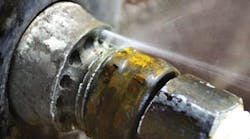Are your water bills creeping up? Your plumbing may be suffering from undetected leaks that drive up utility charges and may cause repair needs.
Inspect your facility for tell-tale signs of these five potential leaks.
1) Chemical Reactions
Some water treatment chemicals gradually create miniscule holes in copper pipes and brass valves, notes Larry Snow, a project manager for FM provider Crockett Facility Services. Look for green residue on the outside of the pipe to find weak spots before they leak.
"Most of the leaks come from the bottom of a pipe, usually where it's been put together with an elbow," Snow explains. "The water sits for a while and tries to eat pinholes in the pipe."
A major flood in one of the buildings Snow manages was caused in part by pinholes that developed in a brass pressure regulating valve. Though the hole was no bigger than one-sixteenth of an inch, water (pressurized at 80 psi) sprayed out for a few hours before the leak was detected, resulting in repair costs of over $53,800.
Hot water can cause additional problems for vulnerable equipment, Snow says. For instance, if you have a separate hot water faucet on your breakroom sink that's fed by a heating element underneath, keep an eye out for hard, chalky white residue on the pipes or housing – it's a sign that water is seeping out.
"Instant water heaters are great as long as you monitor them. If you have engineers on-site 24/7 who are making rounds every four hours or so, they can look for warning signs," says Snow. "But if you only have someone like a guard at night and he doesn't check it, the unit could leak for hours."
Also, be aware that log-busting chemicals can cause problems in commercial kitchens, adds John B. Giacoma, owner and founder of J.B. Giacoma Consulting: "Restaurant kitchens might throw some Drano down the drain, and the next thing they know, they have a leak in the pipe that goes from the dishwasher to the grease trap."
2) Deferred Maintenance
Many owners and managers don't perform the recommended maintenance on their gate valves, Snow notes. This simple step requires you to open and close each valve twice at least once a year.
"The biggest problem I find in buildings is that none of the valves are exercised, so they freeze up," explains Snow, who encountered unexercised valves during the flooding in his building. "When you need to close them, they leak, so you have to go two or three valves downstream until you can get the water stopped."
Solenoids and other valves in commercial dishwashers are vulnerable too, Giacoma adds, so make sure you keep up with maintenance if your facility has a kitchen.
3) Using the Wrong Hose
Refrigerators with ice makers are prone to malfunction if a residential water supply hose is used, says Snow.
"Instead of using a stainless steel braided hose for the water supply to the ice maker, sometimes a clear plastic hose is used," explains Snow, who keeps a supply of steel hoses in stock for such discoveries. "Your home refrigerator usually runs between 45 to 50 psi, but in a commercial building, you're dealing with about 80 pounds, so a plastic quarter-inch hose can't last forever."
4) Blockages
Building occupants who flush inappropriate items can cause a toilet to overflow, explains Giacoma, but urinals can suffer from a more gradual buildup that eventually leads to a hazardous situation.
"Urinals that don't have enough flush can accumulate calcium deposits inside the pipe. If you don't keep them clean, flushes can start going over the rim," says Giacoma. "Then you've got a slipping problem."
5) Inappropriate Pressure
When was the last time you tested your pressure regulators? If your answer is more than a year ago, make sure you add them to your annual PM plans, along with backflow preventers. Both should be serviced once a year.
"Adjust the regulator valve while watching the gauge," Snow recommends. "Start with less pressure and watch your gauge, then add more pressure, watch your gauge, and return the setting to where it should be. This is something most mechanics and building engineers don't do, but you pay for it down the road because it comes back to bite you."
Washroom plumbing can also run into problems when pressure is too high.
"I have a lot of issues with stop valves, which shut off water for the flush valve," Snow explains. "Pressure is causing the flush valves to not hold. Pressure regulating valves should be installed on every floor at a set pressure no higher than 60 psi, and each one should have an isolation valve with it."
Janelle Penny [email protected] is senior editor of BUILDINGS.



